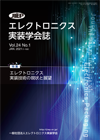Volume 24, Issue 3
Displaying 1-18 of 18 articles from this issue
- |<
- <
- 1
- >
- >|
Preface
-
Article type: Preface
2021Volume 24Issue 3 Pages P3
Published: May 01, 2021
Released on J-STAGE: May 01, 2021
Download PDF (185K)
Special Articles / Trends of Power Electronics
-
Article type: Special Articles
2021Volume 24Issue 3 Pages 209
Published: May 01, 2021
Released on J-STAGE: May 01, 2021
Download PDF (266K) -
Article type: Special Articles
2021Volume 24Issue 3 Pages 210-214
Published: May 01, 2021
Released on J-STAGE: May 01, 2021
Download PDF (659K) -
Article type: Special Articles
2021Volume 24Issue 3 Pages 215-225
Published: May 01, 2021
Released on J-STAGE: May 01, 2021
Download PDF (2386K) -
Article type: Special Articles
2021Volume 24Issue 3 Pages 226-232
Published: May 01, 2021
Released on J-STAGE: May 01, 2021
Download PDF (1883K) -
Article type: Special Articles
2021Volume 24Issue 3 Pages 233-240
Published: May 01, 2021
Released on J-STAGE: May 01, 2021
Download PDF (2651K)
Technical Paper
-
Article type: Technical Paper
2021Volume 24Issue 3 Pages 241-249
Published: May 01, 2021
Released on J-STAGE: May 01, 2021
Advance online publication: January 25, 2021Download PDF (2358K) -
Article type: Technical Paper
2021Volume 24Issue 3 Pages 250-256
Published: May 01, 2021
Released on J-STAGE: May 01, 2021
Advance online publication: February 25, 2021Download PDF (1441K) -
Article type: Technical Paper
2021Volume 24Issue 3 Pages 257-267
Published: May 01, 2021
Released on J-STAGE: May 01, 2021
Advance online publication: March 22, 2021Download PDF (1631K) -
Article type: Technical Paper
2021Volume 24Issue 3 Pages 268-276
Published: May 01, 2021
Released on J-STAGE: May 01, 2021
Advance online publication: March 22, 2021Download PDF (1691K)
Technical Report
-
Article type: Technical Report
2021Volume 24Issue 3 Pages 277-280
Published: May 01, 2021
Released on J-STAGE: May 01, 2021
Advance online publication: January 25, 2021Download PDF (1020K)
Report
-
Article type: Report
2021Volume 24Issue 3 Pages 281
Published: May 01, 2021
Released on J-STAGE: May 01, 2021
Download PDF (383K)
Announcement, Contents, etc.
-
Article type: Announcement
2021Volume 24Issue 3 Pages 282
Published: May 01, 2021
Released on J-STAGE: May 01, 2021
Download PDF (235K) -
Article type: Announcement
2021Volume 24Issue 3 Pages 284-286
Published: May 01, 2021
Released on J-STAGE: May 01, 2021
Download PDF (413K) -
Article type: Announcement
2021Volume 24Issue 3 Pages A31-
Published: May 01, 2021
Released on J-STAGE: May 01, 2021
Download PDF (566K) -
Article type: Announcement
2021Volume 24Issue 3 Pages C31
Published: May 01, 2021
Released on J-STAGE: May 01, 2021
Download PDF (193K) -
Article type: Announcement
2021Volume 24Issue 3 Pages C32
Published: May 01, 2021
Released on J-STAGE: May 01, 2021
Download PDF (168K) -
Article type: Announcement
2021Volume 24Issue 3 Pages I31-
Published: May 01, 2021
Released on J-STAGE: May 01, 2021
Download PDF (511K)
- |<
- <
- 1
- >
- >|
